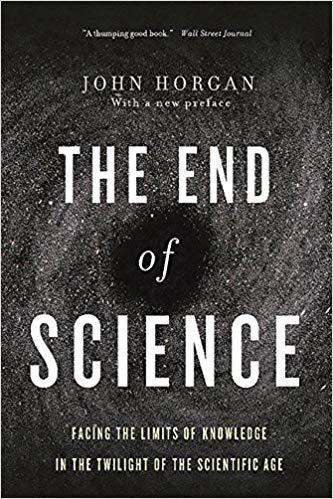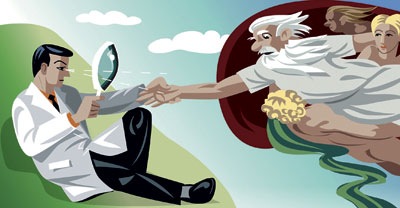 |
 |
A Review of John Horgan, The End Of Science: Facing the Limits of Knowledge in the Twilight of the Scientific Age (Basic Books, 1996, 2015)
My grandfather preached the good news of the Bible
My father preached the good news of Socialism
I preach the good news of Science
The above slogan once seemed eminently reasonable since science has delivered unparalleled knowledge and technology to create modern civilisation. However, in recent years there has been increasing suspicion that science may be serving its profound knowledge in a poisoned chalice. Science creates more problems than it solves – problems all too familiar in the form of environmental disasters and weapons of mass destruction.
Perhaps many scientists remain blissfully unaware, if not indifferent, to this deep unease. After all, the prevailing image of the scientist is someone dressed in white clinical apparel working quietly in sanitised labs, oblivious to the hassles and tensions of life outside. But, we wonder, how can the dull routines of the lab, such as cleaning test tubes and animal cages, sustain the motivation for scientific research in the face of increasing doubts and criticisms? John Horgan, a senior writer for Scientific American and author of the book The End of Science, exploits his literary expertise effectively to offer vivid introductions and personal insights into the aspirations, audacity and hubris of some of the major icons of the scientific pantheon: Richard Dawkins, Francis Crick, Murray Gell-Mann, Stephen J. Gould, Roger Penrose and Ilaya Prigogine.
Horgan reminds me of the street artist who deftly paints a striking portrait in a few quick strokes. The interviews that form the bulk of the book cleverly allow the prominent scientists and philosophers of science to share in their own words the passions that drive human researchers. Horgan stresses that scientists are not merely knowledge-acquisition machines; they are guided by emotion and intuition as well as cold reason and calculation. Scientists are also people who desire glory, grants and goodies. Naturally, they are concerned with doubts about their enterprise because they strongly believe that the quest for knowledge is by far the noblest and most meaningful of all human activities.
Doubts about science have indeed become widespread. Horgan details a series of developments symptomatic of the failure of nerves among philosophers of science. First, Karl Popper deflated the scientists who aspire to attain final truth. Popper insists that scientific theories continually develop only as “conjectures”. The scientist’s job is not to verify theories which, in any case, is impossible; he has only a modest task of trying to falsify them. Second, Thomas Kuhn has argued that there is no common standard of truth to evaluate competing scientific theories. The basic reason for this is that scientists operate from competing knowledge frameworks (paradigms) which skew their reading of data. Adopting a new theory amounts to a personal conversion. Schools of science are overthrown not by rational persuasion so much as by supplanting them through scientific revolutions.
Still, some scientists take comfort in possessing a systematic research – the scientific method – that yields reliable knowledge. Unfortunately, the enfant terrible Paul Feyerabend in his influential book Against Method argued that philosophy cannot provide a definite methodology or rationale for science. Research can only be intuitive and ad hoc. Anything goes! Science is now haunted by the spectre of relativism.
It seems unthinkable, but we are confronted by the possibility of an “End of Science”. Horgan deliberately chooses the phrase which has double meanings.
First, we are at the “End of Science”, meaning its completion, precisely because all the major laws of science have been discovered. There is even talk of the eventual formulation of “the final theory” – a combination of relativity theory and quantum cosmology along the lines pf superstrings which will adequately explain all scientific problems.
However, the legendary physicist, Richard Feynman offered a pessimistic outlook for physics. He draws an analogy that just as we can only discover America once and thereafter map out the details of the continent, modern scientists can only refine the theories of their founding fathers and quibble over footnotes. Science has reached its limits precisely because of its success.
Second, the “End of Science” also concerns disputes over its purpose. Science just cannot answer questions pertaining to the purpose and meaning of existence. Then again, there may yet be intractable problems that science cannot solve, such as the emergence of life and the absolute origin of the universe. Instead of wrecking their brains in frustration, scientists should set aside their hubris and accept cognitive limits to our mental apparatus. We have no problem accepting the fact that lizards (or even many humble mortals) will never understand quantum mechanics. Why can’t we accept that there are limits to our mental apparatus?
How can scientists cope with this ominous challenge? The uncompromising scientific realist (in contrast to the scientific instrumentalist) will retort that such doubts are misguided. Surely, the scientific realist insists, there is nothing relative in the periodic table or in insulin curing diabetes. Such retorts, however, only amount to guerrilla sniping unless such scientists demonstrate that the enterprise continues to widen the horizon of knowledge.
Richard Dawkins maintains that critics are only worrying over pseudo problems. We should cheerfully accept that there is no longer any mystery after Darwin and Wallace. The scientist should not be distracted by futile metaphysical questions. He seeks only to explain the mechanisms causing changes in nature. But by the same token, Dawkins’ footnoting amounts to reductionism which insists on the explanation ‘Nothing but’. For Dawkins all human virtues are nothing but selfish genes. Francis Crick declares that “Our identities are nothing more than an assembly of nerve cells” while Daniel Dennett asserts that we have no minds, only the good tricks of a more or less virtual computer. In anticipation that we will call his bluff, Dennett insists without batting an eye that we are all zombies, granted that we are highly complex zombies. Presumably, even a zombie philosopher must be taken seriously!
No wonder students react with existential despair when overwhelmed by the mechanistic picture of human nature championed by B. F. Skinner or Francis Crick. Their despair echoes that of Blaise Pascal who confessed that in the absence of a personal Creator, the silence and barrenness of the universe terrifies him.
Scientists may also cope with the “End of Science” by upping their stakes. This is like fans who cheer even louder when their team is losing. Thus we see in recent years a flourishing of speculative theories of the world in the name of science. Scientists construct complex and fascinating models of the universe. We hear reverential expositions of the theories of Alan Guth who speculates that the universe began with a kink in a quantum field, resulting in a rapidly inflating bubble universe. John Wheeler surmises the way new worlds may emerge in a multiverse, that is, a many-worlds universe. Most famous of them all, Stephen Hawking, using calculations based on imaginary time speculates on a self-contained universe having no boundary or edge.
Scientists may also magnify the promise of future science. Frank Tippler intimates how future intelligent machines will convert the universe into a gigantic information processing device. Everyone of us will be ‘resurrected’ as a computer simulation. Mankind at last gains immortality albeit in a virtual world called Omega Point. Beyond cold comfort, it is hard to differentiate between facts and fantasy in these speculations, although I suspect that a TV generation brought up on Star Trek may have no problem with virtual immortality.
These writers wax supreme, spinning theories that are profound and indeed intoxicating. Unfortunately their theories are just not open to empirical testing. These theories remind me of magnificent but imaginary castles that just do not touch ground. Too bad no one can live in them. They only exist in the minds of speculative scientists.
Horgan notes that when particle physics passes beyond the realm of the empirical, it may succumb to scepticism and to relativism. For the first time since the Dark Ages the noble quest for knowledge ends with faith replacing science again. Horgan helpfully suggests that we make a distinction between real science and ironic science. While real science generates fruitful theories that can be tested, ironic science is more akin to literary criticism where theories are accepted on grounds of aesthetic appeal of some abstract mathematical equations. So much then for the hype of the likes of Paul Davis, John Barrow and Stephen Hawking which seems to be whistling in the dark.
Howard Georgi, a particle physicists at Harvard, remarks that the cosmologists’ talk of wormholes, time travel and baby universes are amusing. He further says that the inflationary theory of the universe hides its real status as merely a wonderful ‘creation myth’. In the beginning was the quantum equation. God is the ultimate geometry expert. But religionists find little attraction to the physicist’s god who is only an elusive and aloof cosmic engineer. For all their claims, the new scientific speculations are not addressing the quandaries of life. No wonder then that those seeking answers to the problems of practical life prefer to grope in the dark elsewhere.
Unwarranted speculations will only undermine the credibility of science as reliable knowledge. Worse, real science gets hijacked by prophets of pseudo-science. Hence the disturbing resurgence of superstitions in our society ranging from feng shui to new age therapies which have gained new respectability because they couch their speculations in pseudo-scientific language.
John Horgan has provided us with an entertaining report on the ambivalence that vexes modern scientists. His many amusing but astute interviews impress the reader that science is a thoroughly human enterprise complicated by human passions, hopes and anxieties. As such our expectations will end up as disappointments if they go beyond what human scientists can deliver.
On the other hand, we misconstrue Horgan’s concerns if the call for modest expectations is taken as disillusionment with science. After all, no other human discipline can match the achievement of science in generating reliable knowledge and technological marvels. Science epitomizes the glory and dignity of man. As Pascal wrote, although man is only a fragile reed, he is superior to the universe by being a thinking reed.
Life reduced to abstract rationality is too impoverished to be worth pursuing. At the same time, to reject a rational approach to life would render us vulnerable to deceptions and superstitions that once held us bondage to the fear of the unknown.
Bonus Links:
The Paradox of Karl Popper – A interview with Karl Popper by John Horgan published by Scientific American in 1992. Popper displays a remarkably sharp mind at the age of 90 as he peppers the interview with scintillating insights.
Being Tough Minded in an Age of Credulity – A nod to Carl Sagan
Related Posts on Science and Christianity. 6 Parts.
Part 1: Is there a War between Science and Religion?
Part 2: Christianity and the Rise of Modern Science.
Part 3: The Scope and Limits of Science: A Response to Scientism.
Part 5: Models of Integrating Science & Christianity.
Part 6: Science and Theology as Analogous Research Programmes.